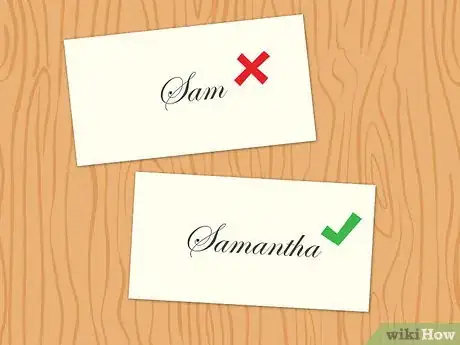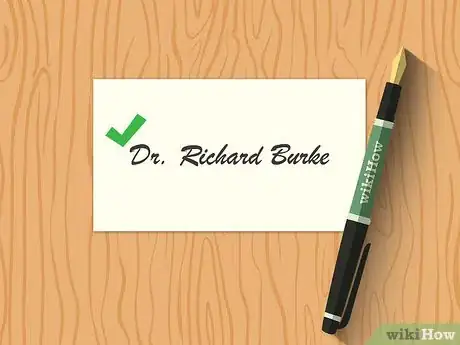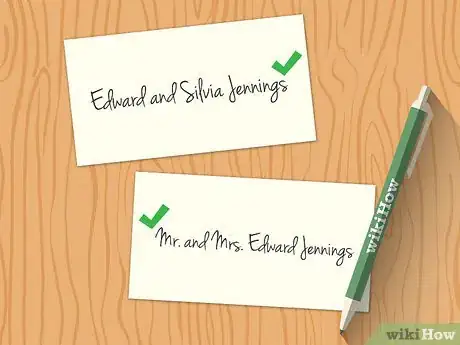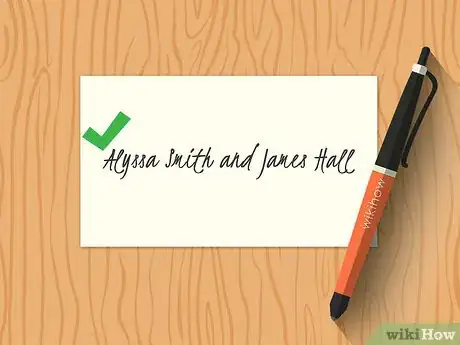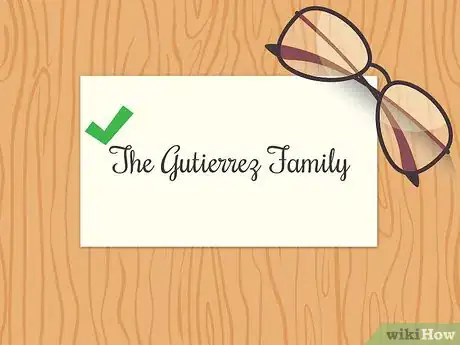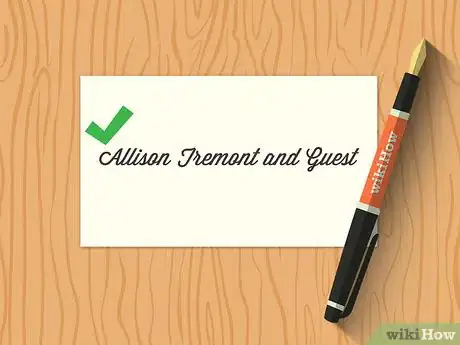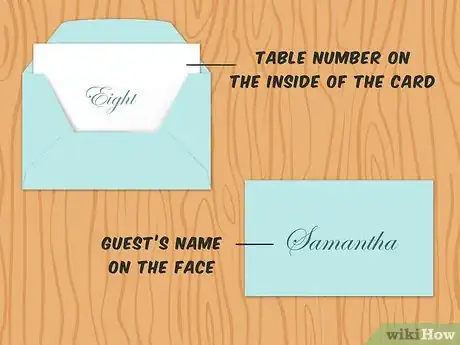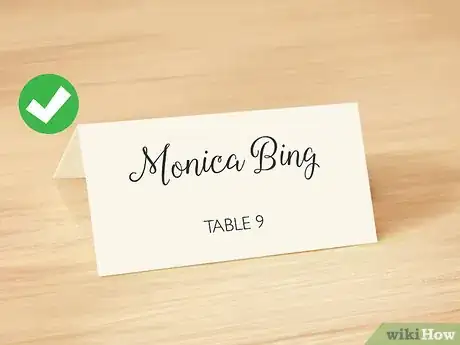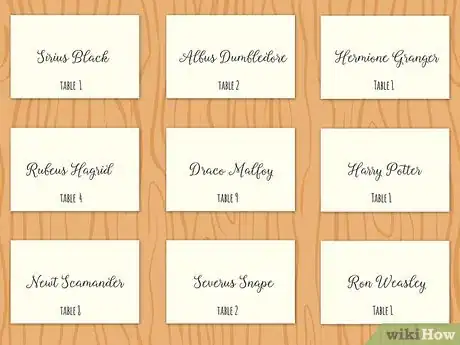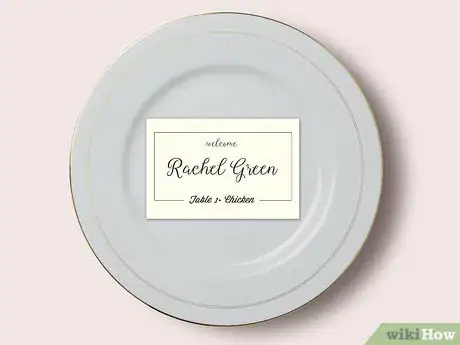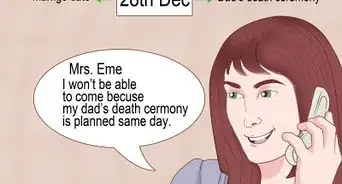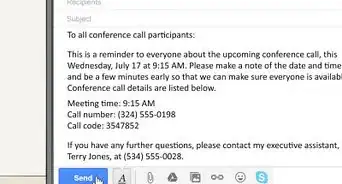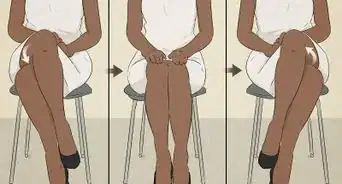This article was co-authored by Minoti Mehta. Minoti Mehta is the Founder of Vermilion Weddings & Events, an event and wedding planning business based in San Francisco, California. Minoti grew up in the event and wedding planning space and has over five years of event planning experience. She has been invited to participate as a Delegate at five exclusive Event Planner Conferences including Destination Wedding Planners Congress and Planners Xtraordinaire and has become known as one of the Top Wedding and Event Planners in the San Francisco Bay Area. Minoti's work has been featured on NDTV India, Love Stories TV, Maharani Weddings, and WedWise India. Vermilion Weddings & Events was also awarded WeddingWire's Couple's Choice Award in 2018. Minoti has a BS in Hospitality Management and Accounting from the University of San Francisco.
There are 7 references cited in this article, which can be found at the bottom of the page.
This article has been viewed 44,312 times.
Escort cards are used to direct guests to their assigned tables at wedding receptions. When putting together a batch of escort cards for your wedding, it’s important to know the right way to address your guests in order to honor them for their attendance and avoid confusion. As a rule, it’s generally best to use full names to identify solo attendees and unmarried couples, and group married couples and families together by their last names.
Steps
Formatting Your Guests’ Names
-
1Address individual guests using their full name. Guests who are planning on showing up by themselves need only be identified by their first and last name. Consider including the person’s middle initial if they have a common name that may be shared with other guests.[1]
- Unless your wedding is going to be an informal celebration, don’t use abbreviations or nicknames—write “Samantha” instead of “Sam” and “William” rather than “Bill.”
- An escort card for an unaccompanied guest might simply read: “John B. McLemore.”
-
2Use titles consistently. It’s alright to refer to your guests as “Mr.” and “Mrs.” as long as you do it for each and every person in attendance. Similarly, you might choose to list unmarried women either by their first and last names or with the additional descriptor “Miss,” but try to keep it the same on each card.[2]
- Special titles like “Dr.” and “Father” can be reserved for distinguished guests as a way of showing respect.[3]
- It’s usually okay to address children under the age of 13 without titles.
Advertisement -
3List married couples by their last name. Traditionally, married couples are presented as a pair under the husband’s name, as in “Mr. and Mrs. Edward Jennings.” These days, it’s also acceptable to use both the husband and wife’s names, as in “Edward and Silvia Jennings.”[4]
- You might also be able to get away with using the couple’s last name alone if it’s a smaller wedding and there are no other couples with the same surname in attendance.
- Married couples should always be listed together on the same card.
-
4Put the woman’s name first on cards for unmarried couples. This goes for guests with dates, engaged couples, and male-female friends coming to the reception together. The same rule can also apply to married couples with different last names. Giving precedence to the woman is considered a polite gesture.[5]
- If you have a close male friend who is bringing his new girlfriend, you would write “Leslie Schaeffer and Christopher Hudson.”
- When addressing an escort card to a same-sex couple, you have the option of either listing the names alphabetically or starting with the name of the guest you’re better acquainted with.
-
5Use a single card for families who will be seated together. It’s common for family groups to be addressed collectively. The only exceptions are especially large families and occasions when 1 or more members will be accompanied by their own families, such as a husband and wife arriving independently of 1 spouse’s parents and younger siblings.[6]
- A card reading “The Gutierrez Family” can account for any number of related guests who have RSVPd to confirm their attendance.
- Putting whole families down on the same escort card saves you the trouble (and extra materials) of making cards for each person individually.
-
6Note unidentified guests after the name of the person they’re with. It’s usually sufficient to tack on an “and guest” after the invited guest’s name. Making it a point to mention a guest’s plus-1 is a common courtesy, and can be helpful when you don’t know the person’s name or haven’t yet been formally introduced to them.[7]
- If your teenage niece is coming with her best friend who you’ve never met, instance, writing “Allison Tremont and Guest” will allow you to formalize her escort card without making her friend feel left out.
- Failing to acknowledge an attendee’s guests could offend both parties unintentionally.
Displaying Your Escort Cards
-
1Seal your escort cards in envelopes. According to custom, escort cards are tucked into miniature envelopes to be opened by the guests as they enter the reception area. If you decide to use envelopes, you’ll write the guest’s name on the face of the envelope and record their table number on the inside of the card itself.[8]
- Envelopes are not only more formal, they also add an element of fun and surprise to the proceedings, since guests will have to open their cards to find out what table they’ve been assigned to.
-
2Go with tent-style cards for quick and easy seating. These days, many married couples prefer to keep things simple by using single-piece folding cards in lieu of stuffing each card into its own envelope. When using tent-style cards, display the guest’s name on the outside of the card above their assigned table number, or list the table number separately on the card’s interior.
- The major benefit of tent-style cards is that your guests will be able to pick them out and read them much faster, preventing a traffic jam at the entrance to the reception area. However, it also involves less work for you.
-
3Set out your escort cards in rows alphabetically. To make it easier for your guests to pick out their cards, organize them from A-Z by last name on a large table in your reception area. Arrange them in neat rows, with the front of each card plainly visible. That way, they can simply scan each row until they find their card and be on their way.[9]
- Someone with the last name “Adams,” for instance, should be able to spot their card closer to the front of the table than a couple by the name of “Watanabe.”
- If you have more than 1 married couple with the same last name, include the husband’s first name so it’s clear who you’re referring to (“Mr. and Mrs. David Johnson,” as distinct from “Mr. and Mrs. Steven Johnson”).
-
4Use matching table and place cards for assigned seating. If you intend to designate both the table and individual seat of each guest at your wedding reception, you’ll need to create table and place cards as well. Double-check that the names and numbers on your escort cards correspond with those on the place and table cards to avoid confusing or misplacing your guests.[10]
- Table cards are large placards used to identify each table in the reception area. They’re typically numbered, but you could also assign your guests to tables named after your favorite flowers, songs, authors, or world wonders—get creative!
- Place cards display the names of the guests at a particular table so that everyone knows who everyone else is. It will be necessary to print a separate place card with a unique seat number for each guest, rather than grouping them together the way you did on the escort cards.
Sample Escort Cards
Expert Q&A
-
QuestionDo you put couples on place cards?
 Minoti MehtaMinoti Mehta is the Founder of Vermilion Weddings & Events, an event and wedding planning business based in San Francisco, California. Minoti grew up in the event and wedding planning space and has over five years of event planning experience. She has been invited to participate as a Delegate at five exclusive Event Planner Conferences including Destination Wedding Planners Congress and Planners Xtraordinaire and has become known as one of the Top Wedding and Event Planners in the San Francisco Bay Area. Minoti's work has been featured on NDTV India, Love Stories TV, Maharani Weddings, and WedWise India. Vermilion Weddings & Events was also awarded WeddingWire's Couple's Choice Award in 2018. Minoti has a BS in Hospitality Management and Accounting from the University of San Francisco.
Minoti MehtaMinoti Mehta is the Founder of Vermilion Weddings & Events, an event and wedding planning business based in San Francisco, California. Minoti grew up in the event and wedding planning space and has over five years of event planning experience. She has been invited to participate as a Delegate at five exclusive Event Planner Conferences including Destination Wedding Planners Congress and Planners Xtraordinaire and has become known as one of the Top Wedding and Event Planners in the San Francisco Bay Area. Minoti's work has been featured on NDTV India, Love Stories TV, Maharani Weddings, and WedWise India. Vermilion Weddings & Events was also awarded WeddingWire's Couple's Choice Award in 2018. Minoti has a BS in Hospitality Management and Accounting from the University of San Francisco.
Event & Wedding Planner I think it's nicer to have a separate card for each guest, so I like to address them all individually rather than pairing together as "Mr. and Mrs." for couples.
I think it's nicer to have a separate card for each guest, so I like to address them all individually rather than pairing together as "Mr. and Mrs." for couples. -
QuestionFor informal escort cards using first and last names, no titles, is it appropriate to include Dr. on an escort card, or just his first and last name like the other cards?
 Tom De BackerTop AnswererAs your cards are informal, I would omit the Dr. and go with first and last name like the others. Yes, he's a doctor, but right now he's also being himself as a guest at the wedding, so it would be more personal to just use his name, not his title.
Tom De BackerTop AnswererAs your cards are informal, I would omit the Dr. and go with first and last name like the others. Yes, he's a doctor, but right now he's also being himself as a guest at the wedding, so it would be more personal to just use his name, not his title. -
QuestionWhat if one of the family members is a doctor?
 Tom De BackerTop AnswererAs the article states, it's OK to use titles such as "Dr" or "Father" as a sign of respect, as long as you do this consistently.
Tom De BackerTop AnswererAs the article states, it's OK to use titles such as "Dr" or "Father" as a sign of respect, as long as you do this consistently.
References
- ↑ http://www.formsofaddress.info/Placecards.html
- ↑ https://www.marthastewartweddings.com/226125/seating-cards-weddings
- ↑ https://ipfs.io/ipfs/QmXoypizjW3WknFiJnKLwHCnL72vedxjQkDDP1mXWo6uco/wiki/English_honorifics.html
- ↑ https://www.brides.com/story/wedding-escort-card-ideas-questions-answers
- ↑ https://www.marthastewartweddings.com/226125/seating-cards-weddings
- ↑ https://www.brides.com/story/wedding-escort-card-ideas-questions-answers
- ↑ https://www.brides.com/story/wedding-escort-card-ideas-questions-answers
- ↑ https://www.perfecttableplan.com/html/hints.html#escortcards
- ↑ https://www.brides.com/story/how-to-have-stress-free-escort-cards
About This Article
When you’re writing escort cards for your guests, you’ll want to address them the right way to avoid confusion. Use your guests' full first names instead of their short versions. If you have 2 people with the same first name, add the initial of their surname to differentiate them. It’s up to you if you want to add titles before their names, but make sure you use them for everyone for consistency. Alternatively, if the family is sitting together, just label the card for the whole family, like “The Smith family.” List married couples on the same card, using both first names, such as “Edward and Silvia Jennings.” For unmarried couples, list the woman first or the person you know best for same-sex couples. For more tips, including how to label plus ones when you don’t know their name, read on!
